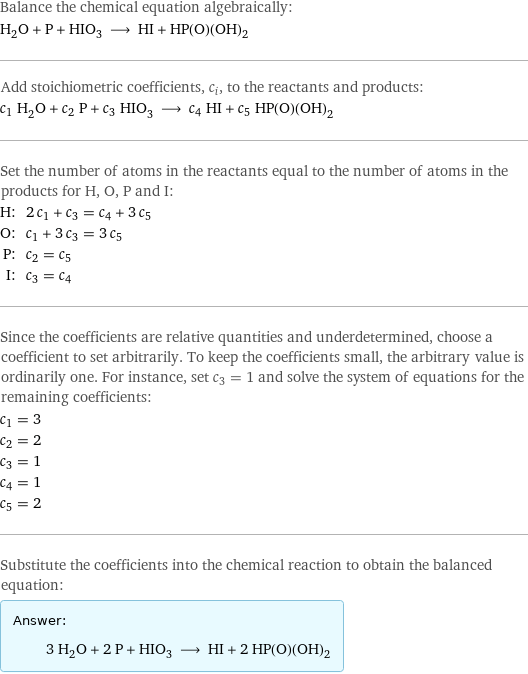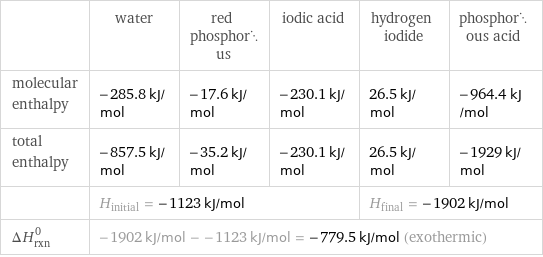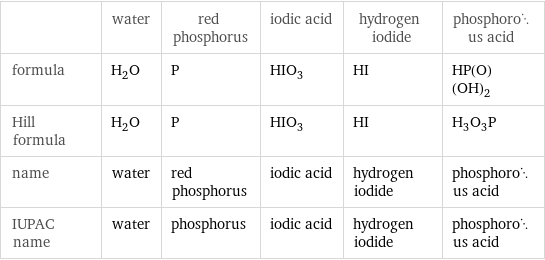Input interpretation

H_2O water + P red phosphorus + HIO_3 iodic acid ⟶ HI hydrogen iodide + HP(O)(OH)_2 phosphorous acid
Balanced equation

Balance the chemical equation algebraically: H_2O + P + HIO_3 ⟶ HI + HP(O)(OH)_2 Add stoichiometric coefficients, c_i, to the reactants and products: c_1 H_2O + c_2 P + c_3 HIO_3 ⟶ c_4 HI + c_5 HP(O)(OH)_2 Set the number of atoms in the reactants equal to the number of atoms in the products for H, O, P and I: H: | 2 c_1 + c_3 = c_4 + 3 c_5 O: | c_1 + 3 c_3 = 3 c_5 P: | c_2 = c_5 I: | c_3 = c_4 Since the coefficients are relative quantities and underdetermined, choose a coefficient to set arbitrarily. To keep the coefficients small, the arbitrary value is ordinarily one. For instance, set c_3 = 1 and solve the system of equations for the remaining coefficients: c_1 = 3 c_2 = 2 c_3 = 1 c_4 = 1 c_5 = 2 Substitute the coefficients into the chemical reaction to obtain the balanced equation: Answer: | | 3 H_2O + 2 P + HIO_3 ⟶ HI + 2 HP(O)(OH)_2
Structures

+ + ⟶ +
Names

water + red phosphorus + iodic acid ⟶ hydrogen iodide + phosphorous acid
Reaction thermodynamics
Enthalpy

| water | red phosphorus | iodic acid | hydrogen iodide | phosphorous acid molecular enthalpy | -285.8 kJ/mol | -17.6 kJ/mol | -230.1 kJ/mol | 26.5 kJ/mol | -964.4 kJ/mol total enthalpy | -857.5 kJ/mol | -35.2 kJ/mol | -230.1 kJ/mol | 26.5 kJ/mol | -1929 kJ/mol | H_initial = -1123 kJ/mol | | | H_final = -1902 kJ/mol | ΔH_rxn^0 | -1902 kJ/mol - -1123 kJ/mol = -779.5 kJ/mol (exothermic) | | | |
Equilibrium constant
![Construct the equilibrium constant, K, expression for: H_2O + P + HIO_3 ⟶ HI + HP(O)(OH)_2 Plan: • Balance the chemical equation. • Determine the stoichiometric numbers. • Assemble the activity expression for each chemical species. • Use the activity expressions to build the equilibrium constant expression. Write the balanced chemical equation: 3 H_2O + 2 P + HIO_3 ⟶ HI + 2 HP(O)(OH)_2 Assign stoichiometric numbers, ν_i, using the stoichiometric coefficients, c_i, from the balanced chemical equation in the following manner: ν_i = -c_i for reactants and ν_i = c_i for products: chemical species | c_i | ν_i H_2O | 3 | -3 P | 2 | -2 HIO_3 | 1 | -1 HI | 1 | 1 HP(O)(OH)_2 | 2 | 2 Assemble the activity expressions accounting for the state of matter and ν_i: chemical species | c_i | ν_i | activity expression H_2O | 3 | -3 | ([H2O])^(-3) P | 2 | -2 | ([P])^(-2) HIO_3 | 1 | -1 | ([HIO3])^(-1) HI | 1 | 1 | [HI] HP(O)(OH)_2 | 2 | 2 | ([HP(O)(OH)2])^2 The equilibrium constant symbol in the concentration basis is: K_c Mulitply the activity expressions to arrive at the K_c expression: Answer: | | K_c = ([H2O])^(-3) ([P])^(-2) ([HIO3])^(-1) [HI] ([HP(O)(OH)2])^2 = ([HI] ([HP(O)(OH)2])^2)/(([H2O])^3 ([P])^2 [HIO3])](../image_source/8f8099a301da476254838dd96041f6ce.png)
Construct the equilibrium constant, K, expression for: H_2O + P + HIO_3 ⟶ HI + HP(O)(OH)_2 Plan: • Balance the chemical equation. • Determine the stoichiometric numbers. • Assemble the activity expression for each chemical species. • Use the activity expressions to build the equilibrium constant expression. Write the balanced chemical equation: 3 H_2O + 2 P + HIO_3 ⟶ HI + 2 HP(O)(OH)_2 Assign stoichiometric numbers, ν_i, using the stoichiometric coefficients, c_i, from the balanced chemical equation in the following manner: ν_i = -c_i for reactants and ν_i = c_i for products: chemical species | c_i | ν_i H_2O | 3 | -3 P | 2 | -2 HIO_3 | 1 | -1 HI | 1 | 1 HP(O)(OH)_2 | 2 | 2 Assemble the activity expressions accounting for the state of matter and ν_i: chemical species | c_i | ν_i | activity expression H_2O | 3 | -3 | ([H2O])^(-3) P | 2 | -2 | ([P])^(-2) HIO_3 | 1 | -1 | ([HIO3])^(-1) HI | 1 | 1 | [HI] HP(O)(OH)_2 | 2 | 2 | ([HP(O)(OH)2])^2 The equilibrium constant symbol in the concentration basis is: K_c Mulitply the activity expressions to arrive at the K_c expression: Answer: | | K_c = ([H2O])^(-3) ([P])^(-2) ([HIO3])^(-1) [HI] ([HP(O)(OH)2])^2 = ([HI] ([HP(O)(OH)2])^2)/(([H2O])^3 ([P])^2 [HIO3])
Rate of reaction
![Construct the rate of reaction expression for: H_2O + P + HIO_3 ⟶ HI + HP(O)(OH)_2 Plan: • Balance the chemical equation. • Determine the stoichiometric numbers. • Assemble the rate term for each chemical species. • Write the rate of reaction expression. Write the balanced chemical equation: 3 H_2O + 2 P + HIO_3 ⟶ HI + 2 HP(O)(OH)_2 Assign stoichiometric numbers, ν_i, using the stoichiometric coefficients, c_i, from the balanced chemical equation in the following manner: ν_i = -c_i for reactants and ν_i = c_i for products: chemical species | c_i | ν_i H_2O | 3 | -3 P | 2 | -2 HIO_3 | 1 | -1 HI | 1 | 1 HP(O)(OH)_2 | 2 | 2 The rate term for each chemical species, B_i, is 1/ν_i(Δ[B_i])/(Δt) where [B_i] is the amount concentration and t is time: chemical species | c_i | ν_i | rate term H_2O | 3 | -3 | -1/3 (Δ[H2O])/(Δt) P | 2 | -2 | -1/2 (Δ[P])/(Δt) HIO_3 | 1 | -1 | -(Δ[HIO3])/(Δt) HI | 1 | 1 | (Δ[HI])/(Δt) HP(O)(OH)_2 | 2 | 2 | 1/2 (Δ[HP(O)(OH)2])/(Δt) (for infinitesimal rate of change, replace Δ with d) Set the rate terms equal to each other to arrive at the rate expression: Answer: | | rate = -1/3 (Δ[H2O])/(Δt) = -1/2 (Δ[P])/(Δt) = -(Δ[HIO3])/(Δt) = (Δ[HI])/(Δt) = 1/2 (Δ[HP(O)(OH)2])/(Δt) (assuming constant volume and no accumulation of intermediates or side products)](../image_source/4eeb4c679dbe4dd61fa1e6aa37e2dab1.png)
Construct the rate of reaction expression for: H_2O + P + HIO_3 ⟶ HI + HP(O)(OH)_2 Plan: • Balance the chemical equation. • Determine the stoichiometric numbers. • Assemble the rate term for each chemical species. • Write the rate of reaction expression. Write the balanced chemical equation: 3 H_2O + 2 P + HIO_3 ⟶ HI + 2 HP(O)(OH)_2 Assign stoichiometric numbers, ν_i, using the stoichiometric coefficients, c_i, from the balanced chemical equation in the following manner: ν_i = -c_i for reactants and ν_i = c_i for products: chemical species | c_i | ν_i H_2O | 3 | -3 P | 2 | -2 HIO_3 | 1 | -1 HI | 1 | 1 HP(O)(OH)_2 | 2 | 2 The rate term for each chemical species, B_i, is 1/ν_i(Δ[B_i])/(Δt) where [B_i] is the amount concentration and t is time: chemical species | c_i | ν_i | rate term H_2O | 3 | -3 | -1/3 (Δ[H2O])/(Δt) P | 2 | -2 | -1/2 (Δ[P])/(Δt) HIO_3 | 1 | -1 | -(Δ[HIO3])/(Δt) HI | 1 | 1 | (Δ[HI])/(Δt) HP(O)(OH)_2 | 2 | 2 | 1/2 (Δ[HP(O)(OH)2])/(Δt) (for infinitesimal rate of change, replace Δ with d) Set the rate terms equal to each other to arrive at the rate expression: Answer: | | rate = -1/3 (Δ[H2O])/(Δt) = -1/2 (Δ[P])/(Δt) = -(Δ[HIO3])/(Δt) = (Δ[HI])/(Δt) = 1/2 (Δ[HP(O)(OH)2])/(Δt) (assuming constant volume and no accumulation of intermediates or side products)
Chemical names and formulas

| water | red phosphorus | iodic acid | hydrogen iodide | phosphorous acid formula | H_2O | P | HIO_3 | HI | HP(O)(OH)_2 Hill formula | H_2O | P | HIO_3 | HI | H_3O_3P name | water | red phosphorus | iodic acid | hydrogen iodide | phosphorous acid IUPAC name | water | phosphorus | iodic acid | hydrogen iodide | phosphorous acid
Substance properties

| water | red phosphorus | iodic acid | hydrogen iodide | phosphorous acid molar mass | 18.015 g/mol | 30.973761998 g/mol | 175.91 g/mol | 127.912 g/mol | 81.995 g/mol phase | liquid (at STP) | solid (at STP) | solid (at STP) | gas (at STP) | solid (at STP) melting point | 0 °C | 579.2 °C | 110 °C | -50.76 °C | 74 °C boiling point | 99.9839 °C | | | -35.55 °C | density | 1 g/cm^3 | 2.16 g/cm^3 | 4.629 g/cm^3 | 0.005228 g/cm^3 (at 25 °C) | 1.597 g/cm^3 solubility in water | | insoluble | very soluble | very soluble | surface tension | 0.0728 N/m | | | | dynamic viscosity | 8.9×10^-4 Pa s (at 25 °C) | 7.6×10^-4 Pa s (at 20.2 °C) | | 0.001321 Pa s (at -39 °C) | odor | odorless | | | |
Units
